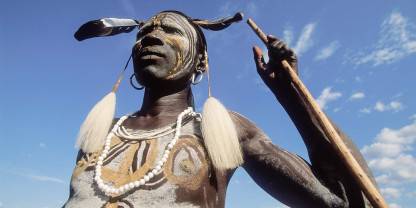Average Expert Rating
Rating Breakdown
Write a User ReviewHome of the Mursi
Read more
area and remained utterly oblivious to the extraordinary tribal lives just off to my west). Today, the Omo Valley and its peoples are one of Ethiopia’s biggest tourist draws. And herein lies the problem. Tourists come to Mago National Park not to see animals but to see and photograph ‘traditional’ and ‘unchanged’ tribal dress and culture. Quite rightly, the Mursi demand money for photographs and they’ve worked out that the more outlandish their dress and body decoration, the more people want to photograph them and the more money they will make. The result is that today what is touted as ‘traditional’ dress is sometimes nothing of the sort (women weave Coca-Cola bottle tops or cow horns into their hair, paint flowers over their bodies and pose with Kalashnikov rifles, none of which would have been seen 15 years ago).For those though who do want to see some of southern Ethiopia’s wildlife, Mago is a decent place to begin. There are buffalo, some elephant, and lots of waterbuck and dik-dik. Due to years of poaching and other harassment most of the wildlife is shy and skittish, but if you’re patient then with luck you will see some mammals. Large mammals or not, what you will certainly see are lots and lots of birds. This is one of the better parks in southern Ethiopia for savannah and acacia forest birdlife and you’ll find birds here that you won’t see in the mountains of northern Ethiopia.
Mursi pride
Mago National Park is an extensive wilderness area, but there isn’t a lot of wildlife left. The reason for my visit was to meet the Mursi people, who live on the bank of the Mago River. I’d already spent a couple of weeks traveling in the Omo Valley, known for its ethnic tribes. It is difficult to comprehend how people can still live such a traditional lifestyle in this day and age. I found the experience partially exhausting, as there’s invariably a voyeuristic element to this kind of tourism, but mostly very sobering as it made me question aspects of my western materialistic lifestyle. The Mursi tribe is known for the distinctive lip-plates worn by the women after they reach puberty. Although there is undeniably a controversial element to these kinds of practices, I feel privileged to have been able to meet these remarkable people and to have had a glimpse into their vanishing culture.

